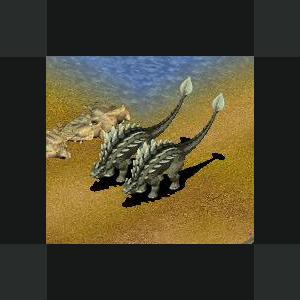About This File
Cedarpelta is the most basal known ankylosaurid ankylosaur (Ankylosauridae; Ankylosauria), based on material recovered from the Lower Cretaceous of North America.
The skull lacks extensive cranial ornamentation, a trait which has been interpreted as plesiomorphic for ankylosaurs. Carpenter et al. (2001) diagnose Cedarpelta by the presence of a rostrocaudally elongate pterygoid with a caudolaterally oriented, trochlear-like process, a premaxilla with six conical teeth, and a straight ischium. The presence of premaxillary teeth is a plesiomorphic character because it is present in other, primitive ornithischians. In contrast, closure of the opening on the side of the skull behind the orbit, the lateral temporal fenestra, is an advanced (apomorphic) character only known in ankylosaurid ankylosaurs.
Two skulls are known, and the skull length for Cedarpelta is estimated to have been roughly 60 cm. Significantly, one of the Cedarpelta skulls was found disarticulated, a first for an ankylosaur skull, allowing paleontologists a unique opportunity to examine the individual bones instead of being limited to a cossified unit. The etymology of this binomen may be read as "Bilbey and Hall's Cedar (Mountain) shield," with the genus named for the Cedar Mountain Formation and the animal's armored plates and the species named for Sue Ann Bilbey and Evan Hall, discoverers of the type locality.
All material referrable to Cedarpelta has been recovered from the Ruby Ranch Member of the Cedar Mountain Formation. Radiometric dates place the site the specimen was collected in the (Albian) of eastern Utah.



Recommended Comments
There are no comments to display.
Create an account or sign in to comment
You need to be a member in order to leave a comment
Create an account
Sign up for a new account in our community. It's easy!
Register a new accountSign in
Already have an account? Sign in here.
Sign In Now